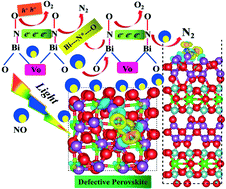Mechanistic insights into the photocatalytic reduction of nitric oxide to nitrogen on oxygen-deficient quasi-two-dimensional bismuth-based perovskites†
Abstract
The decomposition of nitric oxide (NO) into stoichiometric N2 and O2 under ambient conditions merely with light as the driving force remains a great challenge owing to the huge activation barrier for both the cleavage of N![[double bond, length as m-dash]](https://www.rsc.org/images/entities/char_e001.gif) O bonds and the subsequent reconstruction of N
O bonds and the subsequent reconstruction of N![[triple bond, length as m-dash]](https://www.rsc.org/images/entities/char_e002.gif) N triple bonds. In this work, ultrathin SrBi2Nb2O9 with the thickness of three atomic layers was fabricated, and oxygen vacancies (Vo) were spontaneously generated due to the drastically shrunk thickness. Such ultrathin SrBi2Nb2O9 displayed the capability to photocatalytically decompose NO into N2 and O2 at the close-to-stoichiometric ratio, whereas the defect-free counterpart SrBi2Nb2O9 hardly exhibited such activity. Theoretical calculations and in situ FT-IR studies revealed the critical roles of Vo in favoring the adsorption of two NO molecules on the neighboring Bi sites around Vo. In such adsorption mode, the subsequent partial overlapping of electron orbitals of two N atoms guaranteed preferential N–N coupling, based on which the decomposition of NO into N2 and O2via the intermediate of N2O was achieved upon illumination.
N triple bonds. In this work, ultrathin SrBi2Nb2O9 with the thickness of three atomic layers was fabricated, and oxygen vacancies (Vo) were spontaneously generated due to the drastically shrunk thickness. Such ultrathin SrBi2Nb2O9 displayed the capability to photocatalytically decompose NO into N2 and O2 at the close-to-stoichiometric ratio, whereas the defect-free counterpart SrBi2Nb2O9 hardly exhibited such activity. Theoretical calculations and in situ FT-IR studies revealed the critical roles of Vo in favoring the adsorption of two NO molecules on the neighboring Bi sites around Vo. In such adsorption mode, the subsequent partial overlapping of electron orbitals of two N atoms guaranteed preferential N–N coupling, based on which the decomposition of NO into N2 and O2via the intermediate of N2O was achieved upon illumination.

- This article is part of the themed collection: Environmental Remediation


 Please wait while we load your content...
Please wait while we load your content...